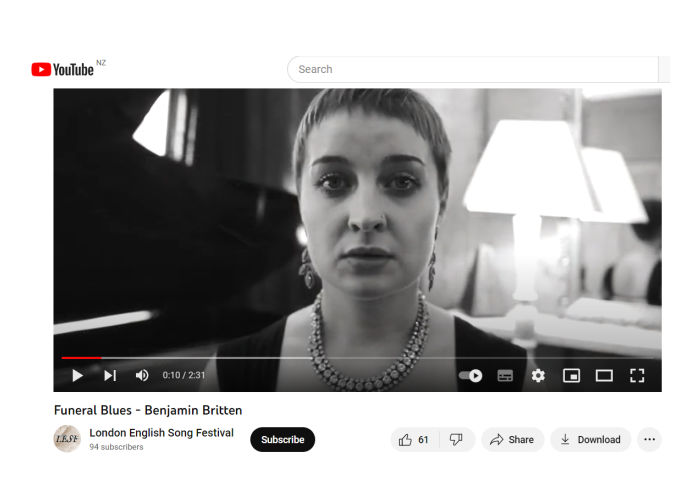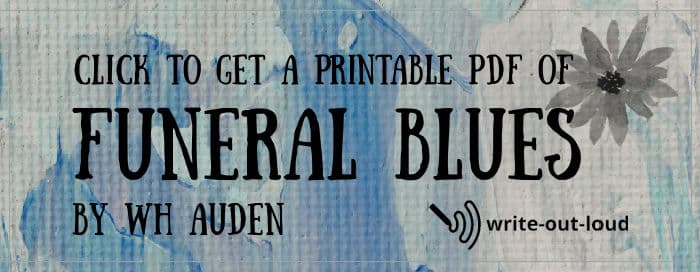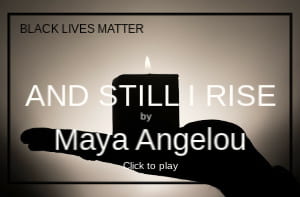- HOME ›
- Resources for eulogies ›
- Funeral Blues by WH Auden
Funeral Blues by WH Auden
That 'Four Weddings and a Funeral' poem aka 'Stop All the Clocks' - analysis, audio, history and printable
By: Susan Dugdale
WH Auden's 'Funeral Blues' poem, also known as (aka) 'Stop All the Clocks', is one of the most loved and most read at memorial services. It's been that way ever since it was movingly recited by actor John Hannah in the enormously successful 1994 English romantic comedy: 'Four Weddings and a Funeral'.
The poem addresses the overwhelming impact the death of a loved one has. It asks, how can anything, or anyone, possibly continue to exist after such an event? From the point of view of the bereaved person, the world, and everything in it, should immediately stop. Or at least, have the decency to go into mourning.
To read the poem, to listen to it, to read an analysis of it, to find out about its history and to download a printable of it for your own use, use the page jump links below.
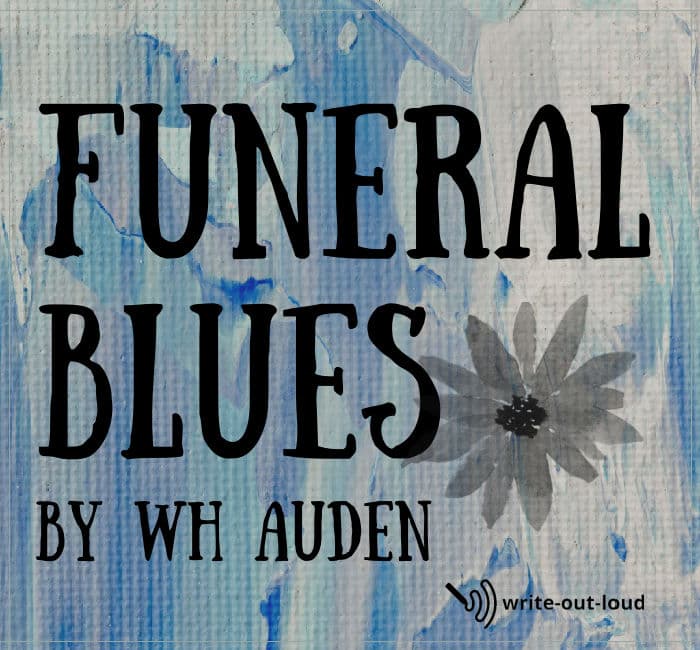
What's on this page
- Funeral Blues (Stop All the Clocks) - the poem
- A recording of Funeral Blues to listen to
- Analysis of Funeral Blues: Stanza 1, Stanza 2, Stanza 3, Stanza 4
- Figures of speech, and more, in Funeral Blues
- A brief history of Funeral Blues
- A printable pdf of Funeral Blues to download for your own use
- Additional resources
Funeral Blues (Stop All the Clocks) by WH Auden
Stop
all the clocks, cut off the telephone,
Prevent the dog from
barking with a juicy bone,
Silence the pianos and with muffled
drum
Bring out the coffin, let the mourners come.
Let
aeroplanes circle moaning overhead
Scribbling on the sky the
message He Is Dead.
Put crepe bows round the white necks of public
doves,
Let the traffic policemen wear black cotton gloves.
He
was my North, my South, my East and West.
My working week and my
Sunday rest,
My noon, my midnight, my talk, my song;
I thought
that love would last forever; I was wrong.
The
stars are not wanted now: put out every one;
Pack up the moon and
dismantle the sun;
Pour away the ocean and sweep up the wood;
For
nothing now can ever come to any good.
Listen to a reading of Funeral Blues
Here's a recording of the poem. The voice you're hearing is mine, Susan Dugdale's. (That's me in the photo in the right-hand column of this page if you're on desktop or below the main content if you're on mobile.)
Analysis of Funeral Blues
'Funeral Blues', or 'Stop All the Clocks', is an *elegy. It has four, four-line *stanzas which use rhyming couplets. The poem makes its point through the extensive use of *hyperbole.
The word 'Blues' in the title links the poem to the blues musical genre and to the expression 'to have the blues'.
Blues music grew out of the suffering caused by slavery and segregation that African-Americans endured. By extension, 'to have the blues' means to be melancholy or depressed.
The linking helps make the poem easily accessible. All of us understand what it is 'to have the blues' and many of us will be familiar with blues music and its common themes: emotional trauma, pain and grief.
* To find out what the words with an asterisk after them mean click the link: Figures of speech in Funeral Blues
Stanza 1: Stop all the clocks, ...
'Stop all the clocks, cut off the telephone,
Prevent the dog from barking with a juicy bone,
Silence the pianos and with muffled drum
Bring out the coffin, let the mourners come.'
The opening stanza is a series of abrupt commands. The speaker, the bereaved person, is issuing instructions about what they want to happen, beginning with the household. By line four, the close of the stanza, they have moved from the private sphere of the home to the public sphere of the street.
The first command, 'Stop all the clocks' is a common 19th century mourning practice from Victorian England. One reason given for it was to allow the soul of the deceased person to move into the next life without worrying about time. Another was to mark the exact time of death.
The next one to 'Cut off the telephone' is a reference to what happened after its inventor, Alexander Graham Bell died in 1922. At that time there were 14 million telephones in USA. At his funeral, as a mark of respect, they were silenced for one minute. (Telephones Were Silenced for One Minute After Alexander Graham Bell Died | Smart News| Smithsonian Magazine)
The speaker assumes that if it could be done for Bell, it can also be done for his beloved who is every bit as important.
It also suggests removal from everyday life: from the busyness of telephones ringing, from chatting and a retreat into silence.
The second line tells whoever is in charge of the household's dog they need to stop it from barking as a mark of respect. Its excitement about having a juicy bone to gnaw should not be allowed to disturb the silence.
The third line continues the theme. Pianos need to be quiet too. At the time the poem was written (1936) pianos in homes were common. People gathered around them to sing, to dance, to enjoy themselves. Therefore, they also need to be shut down.
The remainder of the line, '...and with a muffled drum', and the opening of the following one, 'Bring out the coffin, let the mourners come.', take us from the private realm into the public.
The phrase 'muffled drum' refers to damping down the sound a drum makes when it is beaten. The slow somber beat of muffled drums is part of a military funeral or the funeral of a person of high office.
Such is the grief of the speaker that they expect a throng of mourners to follow the coffin to the graveyard for burial. The supposition is that everyone will feel as they do.
Is this hyperbole*? Absolutely it is. Commonsense tells us so. The world is not going to stop because a person who is deeply loved has died. For 99.99% of us there will be no 'muffled drums' or 'cut off telephones' or anything else the speaker is requesting.
However, the point is not whether or not the demands are reasonable or a deluded exaggeration of the speaker's power to influence public expressions of grief. It is that this is how deeply the speaker feels.
Each command serves to underline and reinforce the importance of the deceased in the speaker's life.
The rhyme scheme for this stanza is AA BB.
Lines 1 and 2 end with telephone and bone. Lines 3 and 4 end with drum and come.
Stanza 2: 'Let aeroplanes circle moaning overhead...'
"Let aeroplanes circle moaning overhead
Scribbling on the sky the message He Is Dead.
Put crepe bows round the white necks of public doves,
Let the traffic policemen wear black cotton gloves."
Stanza two continues the idea that everyone and everything should be involved in marking the death of the beloved. It is now to be a grand public ceremonial occasion, and no effort or expense will be spared.
Lines 1 and 2 continues and extends the military motif. Aeroplanes, likely from the air force are going to fly above the funeral procession writing the message 'He is Dead' in the sky.
Again, this is hyperbole for effect. The use of the word 'moaning' to describe the sound of the aircraft's engines makes the image even more evocative. Even the aeroplanes are in pain!
That they will 'scribble' rather than 'write' adds to the impact too. 'Scribble' tells us more, as does the message, 'He is Dead'.
The use of the word 'He' makes an assumption that everyone who sees the messages will know who they're referring to. He does not need to be named. He needs no introduction. He is famous.
Additionally, 'Dead' gets an uppercase 'd' emphasizing the significance of what happened to Him.
The 3rd and 4th line of the stanza continue the reference to 19th century mourning customs made in the first stanza.
Victorians who could afford it wore clothing made from black silk crepe fabric: dresses, coats, hats, veils... Those who couldn't afford to replace all their clothing wore black crepe neckties, armbands and bows. Wearing black showed everyone you met you had been recently bereaved.
On a literal level we know tying black crepe mourning bows around the necks of the thousands of doves who flock in public places, like a city square, is impossible. It's pure fantasy!
While giving the traffic policemen black cotton gloves in exchange for their normal white ones is not so farfetched, it's still highly unlikely.
The hyperbole in this stanza is even more extravagant than the first. It works, only if we put ourselves in the place of the speaker.
If it were us who had suffered this loss, would we feel similarly? That we would want a unified public outpouring of grief of the sort normally only accorded to the highest-ranking public servants, royalty, an esteemed celebrity or a revered hero?
The deceased was the most important person in our lives: to us a Queen or King, a bright beautiful star... Surely then, just like any other person of note, they too deserve the very best.
The rhyme scheme for this stanza is CC DD.
Lines 1 and 2 end with overhead and dead. (CC) Lines 3 and 4 end with doves and gloves. (DD)
Stanza 3: 'He was my North, my South, ...'
'He was my North, my South, my East and West.
My working week and my Sunday rest,
My noon, my midnight, my talk, my song;
I thought that love would last forever; I was wrong.'
The stanza brings us back to the speaker and lets us know unequivocally what the deceased meant to them through the use of hyperbolic metaphor* and repetition of the word 'my'. (e.g., '...my North, my South, my East and West.')
The first line tells us that he represents every point on the compass: which ever direction the speaker turns, he is there. There is no place without him.
The second line reinforces that idea by saying he is his life every day of the week: work or play. Again, there is no day without him.
The third line repeats the idea using time and voice: how we express ourselves. Regardless of whether it's midnight or noon, talk (spoken language) or song (sung language), he is present.
The cumulative piling of paired metaphors: compass points, (North and South, East and West), days of the week (work and rest), noon and midnight, talk and song, builds to a crescendo that comes crashing down in the fourth line.
'I thought love would last forever; I was wrong.'
The speaker is brutally and abruptly reminded that death is part of life. It's a devastating reality that no amount of love, however strong or enduring, can change.
The rhyme scheme for this stanza is EE FF.
Lines 1 and 2 end with West and rest. (EE) Lines 3 and 4 end with song and wrong. (FF)
Stanza 4: 'The stars are not wanted now:...'
'The stars are not wanted now: put out every one;
Pack up the moon and dismantle the sun;
Pour away the ocean and sweep up the wood;
For nothing now can ever come to any good.'
In the final stanza the speaker returns to issuing instructions- all of them examples of grandiose hyperbole.
This time it's the natural world that is to be packed up - just like you'd clean up, tidy and put away after a special event.
Here the event that's finished is the partnership, love affair or marriage. All the romantic associations of being with your loved one in nature are not wanted any more. They are rude reminders of what was and need to go.
Henceforth, there will be no star gazing, walking in the moonlight, picnicking in the woods, or sunbathing at the beach.
Nature has lost its purpose and value. It needs to be tidied away, out of sight. At best, put into storage.
The last line of the poem, 'For nothing now can ever come to any good.', tells us the speaker has fallen into bleak black hopeless despair.
The rhyme scheme for this stanza is GG HH.
Lines 1 and 2 end with one and sun. (GG) Lines 3 and 4 end with wood and good. (HH)
Figures of speech and more: Funeral Blues
Knowing a little about how and why a poem works can be helpful toward deepening your understanding and appreciation of it.
To that end I've made a few brief notes about the type of poem Funeral Blues is, its structure (how its content/lines are organized) and the principal figures of speech it uses.
What is an elegy?
*An elegy can be either a song or a poem lamenting a death. It could a lament for a person who has died, for places and people destroyed by disasters, (man-made or natural), or for an era that has passed. Its tone is reverent, solemn, sorrowful and reflective.
(The word 'elegy' is often confused with the word 'eulogy'. While they don't have the same meanings, they share a similar purpose: to honor a death. 'Eulogy' is the name given to a formal speech or written piece celebrating the life of a person who has recently died.)
Click the link to read more elegies in this Guardian UK article: From Catullus to Dyland Thomas: the top 10 elegies
What is a stanza?
*A stanza is the name given to a group of lines in a poem. On a printed page or screen, they are visually separated from other lines by a double space or an indentation. A stanza in a poem is the equivalent of a paragraph in an essay or an article.
The word 'verse' and 'stanza' are often used interchangeably. However, there are differences between them. The word 'verse' is much broader is meaning. To find out more click the link: Verse vs. Stanza: What Is the Difference?
What is a rhyming couplet?
*A rhyming couplet is two consecutive lines whose end words have the same or very similar sounds.
For example:
The words at the end of the first two lines in the first stanza of Funeral Blues are telephone and bone. Said aloud they share the same final sound: telephone and bone.
At the end of the next two lines (lines three and four) are the words drum and come. They share the sound: drum and come when spoken.
Funeral Blues has eight rhyming couplets: two in each of its four stanzas.
Funeral Blues rhyme scheme
The rhyme scheme of 'Funeral Blues' corresponds with the spoken sounds used in each of its rhyming couplets.
Because the sound...one from the word telephone is the opening sound, the one at the end of the first line, it is labelled A. And because there are two lines with that sound, (the second is bone), it is written as AA.
Lines 3 and 4 introduce a new sound: drum and come. Therefore, it is given the next letter of the alphabet as its label: B. Those two lines are BB.
So, the rhyme scheme of the first stanza is AA BB, denoting two rhyming couplets.
Every time a sound that hasn't been used previously is introduced, it takes the next letter in the alphabet for its label.
In stanza two the rhyme scheme is CC DD because both C and D are new sounds. The introduction of new sounds also occurs in stanzas three and four and their rhyme schemes are EE FF and GG HH.
What is hyperbole?
*Hyperbole is the deliberate use of extreme exaggeration for emphasis. It is not supposed to be taken literally.
Common examples are 'I'm so hungry I could eat a horse.', or 'I've told you a thousand times already!'.
What is metaphor?
*A metaphor is a figure of speech claiming one thing is another to illustrate or explain something.
For instance, in 'Funeral Blues' using 'He was my North, my South, my East and West.' to express how important the deceased was to him is more powerful than simply saying, 'I loved him.'. It gives us a sense of the totality of his love. Wherever he turned, he was there: at every compass point. There was no place without him.
A brief history of Funeral Blues
Several years after it was written the tone and purpose of 'Funeral Blues' morphed remarkably: undergoing a complete transformation.
An initial version of the poem originally appeared in a 1936 play: 'The Ascent of F6' which WH Auden co-wrote with playwright Christopher Isherwood for an experimental theatre company they both belonged to, called The Group Theatre. Fellow Group member Benjamin Britten composed the music for the show, including a setting for 'Funeral Blues'.
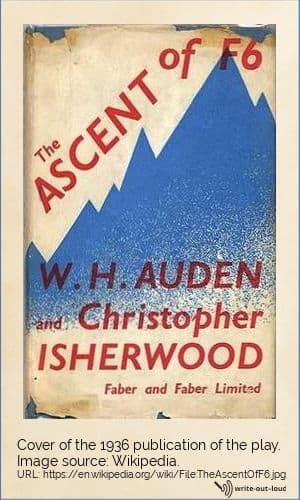
In the context of the play the poem's purpose was to illustrate the extreme and often absurd claims that are sometimes made about a public figure once they are dead: how they become significantly greater than they were in life.
Its lush language echoes and mocks the typically used overblown formulaic expressions of grief while the degree of pomp and ceremonial splendor of their state funeral is beyond credibility. (Even the doves will wear black crepe bows!)
In this setting the tone is satirical, and the extremity of its hyperbole makes the poem a farcical send-up of a state ceremonial funeral.
The poem is revised
Sometime later WH Auden took the poem out of the play, kept the first two stanzas and dropped the last three containing references tying it to its origin.
The reworked version with two new stanzas, the ones we know beginning: 'He was my North, my South ...' and 'The stars are not wanted now ...', appeared in a 1938 anthology called 'The Year’s Poetry'.
Those stanzas transformed the poem into a sincere lament for a true love lost and the mockery and satire apparent in its first iteration vanished.
Funeral Blues becomes a cabaret song
In 1940, the revised 'Funeral Blues' was published once again. This time it appeared under the heading ‘Four Cabaret Songs for Miss Hedli Anderson’ in the collection of Auden's poems 'Another Time'.
Hedli Anderson was a singer and principal performer in the first productions of 'The Ascent of F6'. Benjamin Britten and Auden had been impressed by her ability and collaborated on songs for her to perform.
To listen to 'Funeral Blues' being sung by English mezzo-soprano Katie Bray with William Vann on piano, click either this link, Funeral Blues (Cabaret Songs) by Benjamin Britten with text by WH Auden or the YouTube image below. (The link will open in a new window)
I think it's wonderful!
Four Weddings and a Funeral
Fast forward fifty-four years. In 1994 the hugely successful English romantic comedy 'Four Weddings and a Funeral' was released.
The funeral, referenced in the film's title, included a heartbreakingly poignant reading of 'Funeral Blues' by actor John Hannah in the role of Mathew mourning the death of his partner Gareth. His moving delivery, and the popularity of the film, ensured the poem would go on to be used by countless others all over the world for the same purpose.
Today, several decades after the film first screened, 'Funeral Blues' is one of most loved and frequently read funeral poems.
Download a printable pdf of Funeral Blues
Click the image below to download a printable pdf of Funeral Blues for your own use. (Please note the link for the pdf will open in a new window.)
Additional resources
- Funeral Blues - an excellent in-depth article by Doug Sillett aka Poetry Prof, written primarily for teachers and students who read, teach and study poetry in IGCSE English Literature and World Literature classes.
- A brief biography of WH Auden - a very good overview by William Green on poemanalysis.com
- Funeral Blues - a Wikipedia article with numerous reference links to Auden's work, Christopher Isherwood, Benjamin Britten, analytical pieces, events where the poem has been read ...
Other resources for memorials & funerals
- Poems to read at funerals: a gateway link to three selections of readings for memorial services, audio of four different 'Remember Me' poems (with printables of each of them), plus audio and a printable of these much-loved funeral poems: Do Not Stand at My Grave and Weep, The Prayer of St Francis of Assisi and I Am Standing Upon the Seashore.
- Resources for eulogies - a quick reference directory to all the pages on write-out-loud.com offering practical help to write and deliver a eulogy. There's links to 70+ example eulogies plus step-by-step guidelines for writing, with a printable planner to download and use.
